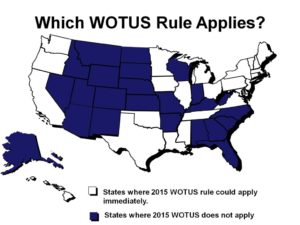
On August 16, South Carolina Federal District Court Judge David Norton issued an order which reinstated the 2015 rule that updated the definition of the Waters of the United States (WOTUS). The EPA and Army Corps of Engineers utilize the definition to determine what waters are jurisdiction of the United States under the Clean Water Act (CWA). The EPA under the Trump administration had amended the 2015 rule to delay the applicability date of it until 2020. Judge Norton ruled that the Trump administration failed to comply with rulemaking requirements under the Administrative Procedure Act in suspending the implementation of the new rule that was adopted under the Obama administration. Specifically, Norton said that the government provided no “reasoned analysis” for delaying the effective date of the rule and no “meaningful opportunity” for public comment. The ruling means that the Clean Water Rule will go into effect in 26 states attached (see map courtesy of www.NAHBnow.com.) The Trump administration is working to repeal the 2015 rule and replacing it with a version of their own.

